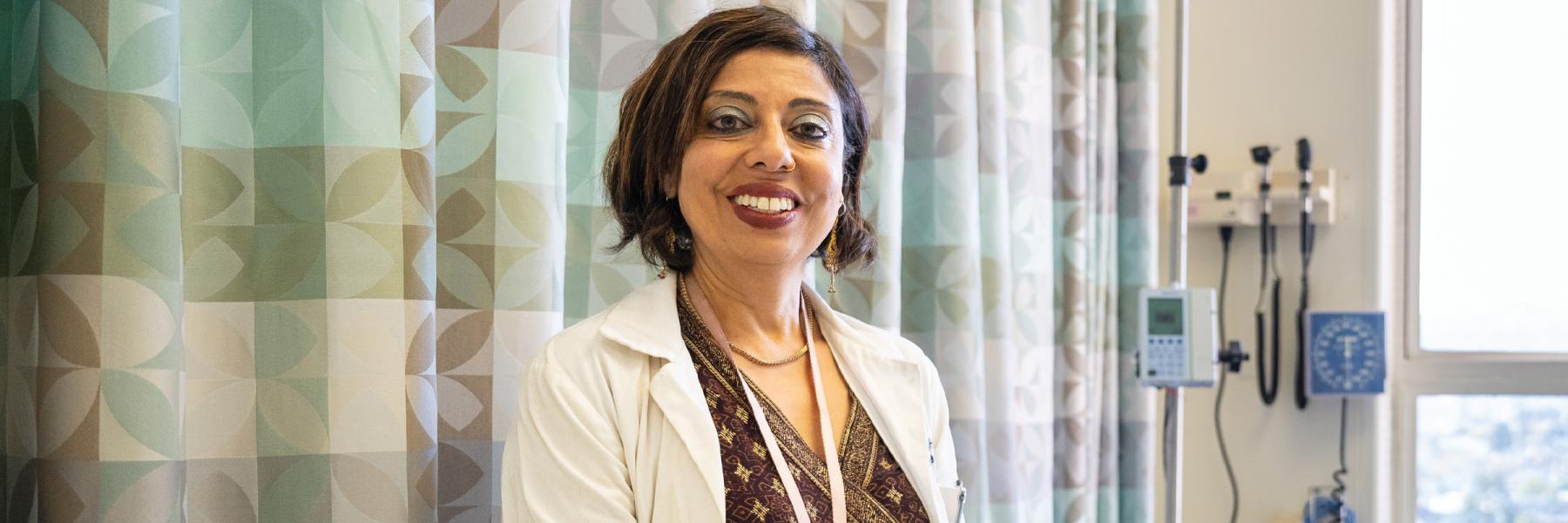People living with HIV who are experiencing homelessness or unstable housing face disparities across the HIV care continuum. In 2021, 17% of people living with HIV in the United States reported homelessness or unstable housing (HUH).1 People experiencing HUH remain significantly less likely to achieve viral suppression than people with stable housing, even among those who access care.2 In San Francisco, people experiencing homelessness account for 24% of people newly diagnosed with HIV and only 27% of people experiencing homelessness were virologically suppressed in 2021 (compared to 75% of those with stable housing).3
People experiencing HUH face significant challenges to adhering to daily oral antiretroviral therapy (ART). Common causes for non-adherence among people with HUH include lost or stolen medications; medications taken by law enforcement during encampment sweeps; lack of food access; stigma; competing basic subsistence needs; forgetting to take medications; insurance lapses or prohibitive co-pays; transportation issues; or the impact of co-existing mental health or substance use disorders. Expanded access to affordable housing is essential to address HIV disparities among people experiencing HUH; however, treatment and care models must respond now to support patients while housing solutions are being proposed and implemented.
‘Our project has led thought leaders in HIV medicine to call for the addition of long-acting ART for individuals who are not virally suppressed.’
Long-acting injectable antiretroviral therapy (LA ART) holds great promise for the treatment of HIV among people experiencing HUH. The U.S. Food and Drug Administration approved injectable cabotegravir (CAB) and rilpivirine (RPV) for dual administration every 4 weeks in both antiretroviral therapy-naïve and antiretroviral therapy-experienced patients in January 2021, and approved a higher dose every 8 weeks in March 2022.4 However, the research trials that led to the approval of LA ART for the U.S. and Europe examined the use of the combination regimen only in study participants who were already virologically suppressed on oral ART. Given that limitation, we need better data to demonstrate if we can use LA ART in patients with challenges to taking oral ART due to housing insecurity or other barriers.
Data on long-acting cabotegravir and rilpivirine in people with detectable viral load who face challenges to adherence are currently limited.5 In 2021, Ward 86, the public HIV clinic in San Francisco, launched the SPLASH (Special Program of Long-Acting Antiretrovirals to Stop HIV) to administer LA ART therapy to our patients. In our demonstration project, where we tracked data carefully and presented it, and we enrolled individuals with detectable viral load who face adherence challenges.6 Many of these patients are seen in the Ward 86 POP-UP program (Positive-health Onsite Program for Unstably-housed Populations), a low-barrier drop-in care model that serves people living with HIV who experience HUH, are not virally suppressed, and have difficulty attending scheduled appointments.7
Studying LA ART for homeless or unstably housed patients with detectable HIV—the SPLASH study
The SPLASH team at Ward 86 (which includes clinic leadership, the pharmacy supervisor, a pharmacy technician, researchers and leadership of the POP-UP program) created a protocol for eligibility, referral, injection administration, follow-up, laboratory monitoring and late injections.8 Between June 2021 and November 2022, 133 people living with HIV were started on long-acting injectable antiretroviral therapy, 76 of whom had virologic suppression while using oral ART and 57 of whom had viremia. In this initial cohort, 77 (58%) were unstably housed and 11 (8%) were living on the street; about a quarter of the patients in our initial SPLASH cohort were enrolled in the POP-UP program. Among people with viremia, 54 of 57 had viral suppression, one showed the expected 2-log reduction in HIV RNA level and two experienced early virologic failure. The current virologic failure rate of 1.5% in the cohort was similar to that across registrational clinical trials at 48 weeks.
Our follow-up data of the first 243 patients on LA ART at Ward 86 is still being analyzed, but the overall virologic success rate among those on LA ART who started with viremia remains high (about 85%). This compares to a rate of only 33% virologic suppression in people who traditionally cannot take oral ART for a variety of barriers, including homelessness, despite incentives and other interventions.9 This project demonstrates the ability of LA ART to achieve virologic suppression among people living with HIV, including those who experience HUH, have viremia and face challenges to adherence.
Our project has led thought leaders in HIV medicine to call for the addition of long-acting ART for individuals who are not virally suppressed to the Department of Health and Human Services (DHHS) Antiretroviral Treatment guidelines when oral pill form medication is not possible due to a variety of challenges.10
LA ART programs still need supportive services
While LA ART in and of itself can assist homeless and unstably housed people who struggle with medication adherence, it’s not just the injection itself that may make the difference. The POP-UP program worked with the SPLASH team at Ward 86 to facilitate people experiencing HUH starting LA ART. Facilitators who helped patients stay in care included a patient cohort who developed a trusting relationship with the POP-UP team; using the same nurse to administer the medications in the clinic, which also builds up trust; call reminders when injections are due; drop-in access that allows patients to come to the clinic to receive their injections when it is convenient for them; a mobile team who can go and find patients if they are late for injections; and an existing multi-disciplinary meeting to discuss patients and develop individualized care plans.
When considering using long-acting injectables in people living with HIV who are experiencing HUH, there are several key considerations. It is important to conduct a rigorous clinical review, reviewing all prior treatment regimens and genotypes (resistance testing) to ensure that the patient does not have drug resistance with any integrase or rilpivirine mutations. If individuals have chronic hepatitis B, they must continue oral medications for hepatitis B. We have also started to use a combination of a novel long-acting capsid inhibitor (lenacapavir)11 with cabotegravir for patients with underlying resistance to rilpivirine or non-nucleoside reverse transcriptase inhibitors (NNRTIs).
The 101 for patients
We ask patients to commit to taking long-acting injectables before enrolling in our program. It is our practice to counsel patients on the long half-life of the injectable medications, and share that if they stopped injectable medications, adherence to oral ART would be key to preventing additional resistance development. Given this, for individuals who face challenges with adherence, we emphasize that this is not a medication to start and then discontinue shortly after. We counsel about the importance of on-time injections and collect contact and location information to ensure that we can reach patients if they are late for their injections. We ask patients to agree to come to the clinic to receive the injection or in rare cases, our team will work with existing resources to deliver injections to the patients where they live. For example, the SPLASH program has partnered with nurses in a San Francisco-based street medicine program or nurses who visit patients in health-at-home programs at low-income housing units in the city. It has been key to have a pharmacy technician to both help acquire the injectable ART regimens from the patients’ medical insurance (which has been easier for patients on public, rather than private, insurance programs in the U.S.) and track when patients are due for their injections. Finally, it is our practice in the POP-UP program to perform in-person outreach if patients are late for their injections. We have started to co-administer the long-acting ART with long-acting medications for psychotic conditions or long-acting medications for substance use disorder treatments when indicated.
Summary
Homelessness and unstable housing are major barriers to HIV care engagement and achieving population-level Ending the HIV Epidemic goals.12 Long-acting injectable medications provide a much-needed alternative strategy for people experiencing homelessness who face significant barriers to adherence to oral ART. While long-acting injectables can be a game-changer for individuals who face challenges to adherence to oral therapy, it is important to deliver them within a clinical program that can support rigorous clinical review, counseling, adherence support and in-person outreach when needed. We think the use of long-acting ART in patients with multiple structural barriers to taking oral ART can be accomplished and will increase rates of virologic suppression in hard-to-reach populations. We encourage clinicians to reach out to us for any questions about our programs for vulnerable populations living with HIV.

Elizabeth Imbert, MD, MPH, is medical lead of POP-UP program at the University of California-San Francisco’s Ward 86 HIV Clinic.

Monica Gandhi, MD, MPH, is medical director of the Ward 86 HIV Clinic at UCSF.
Footnotes
1. CDC. Behavioral and Clinical Characteristics of Persons with Diagnosed HIV Infection—Medical Monitoring Project, United States, 2021 Cycle (June 2021–May 2022). HIV Surveillance Special Report 2023; 32.
2. Clemenzi-Allen A, Geng E, Christopoulos K, et al. Degree of Housing Instability Shows Independent “Dose-Response” with Virologic Suppression Rates Among People Living with Human Immunodeficiency Virus. Open Forum Infectious Diseases. 2018;5(3).
3. HIV Epidemiology: Annual Report, 2021.: San Francisco Department of Public Health; September 2022
4. U.S. Food and Drug Administration.FDA Approves Cabenuva for the Treatment of HIV-1 Infection. 27 January 2021.Accessed at fda.gov/drugs/human-immunodeficiency-virus-hiv/fda-approves-cabenuva-and-vocabria-treatment-hiv-1-infection on29 December 2022
5. Nachega JB, Scarsi KK, Gandhi M, Scott RK, Mofenson LM, Archary M, Nachman S, Decloedt E, Geng EH, Wilson L, Rawat A, Mellors JW. Long-acting antiretrovirals and HIV treatment adherence, The Lancet HIV, Volume 10, Issue 5, 2023, Pages e332-e342, ISSN 2352-3018, doi.org/10.1016/S2352-3018(23)00051-6.
6. Gandhi M, Hickey M, Imbert E, Grochowski J, Mayorga-Munoz F, Szumowski JD, Oskarsson J, Shiels M, Sauceda J, Salazar J, Dilworth S, Nguyen JQ, Glidden DV, Havlir DV, Christopoulos KA. Demonstration Project of Long-Acting Antiretroviral Therapy in a Diverse Population of People With HIV. Ann Intern Med. 2023 Jul;176(7):969-974. doi: 10.7326/M23-0788. Epub 2023 Jul 4. PMID: 37399555.
7. Hickey MD, Imbert E, Appa A, Del Rosario JB, Lynch E, Friend J, Avila R, Clemenzi-Allen A, Riley ED, Gandhi M, Havlir DV. HIV Treatment Outcomes in POP-UP: Drop-in HIV Primary Care Model for People Experiencing Homelessness. J Infect Dis. 2022 Oct 7;226(Suppl 3):S353-S362. doi: 10.1093/infdis/jiac267. PMID: 35759251; PMCID: PMC10233499.
8. Getting to Zero SF—Ward 86 shares updated clinical considerations and recommendations for starting patients on CAB/RPV LA therapy.Accessed at gettingtozerosf.org/ward-86-shares-clinic-hiv-long-acting-injectable-antiretroviral-protocol on 8 May 2023.22
9. Chen W, Gandhi M, Sax PE, Neilan AM, Garland WH, Wilkin T, Cohen R, Ciaranello AL, Kulkarni SP, Eron J, Freedberg KA, Hyle EP. Projected Benefits of Long-Acting Antiretroviral Therapy in Nonsuppressed People with Human Immunodeficiency Virus Experiencing Adherence Barriers. Open Forum Infect Dis. 2023 Jul 22;10(8): ofad390. doi: 10.1093/ofid/ofad390
10. Sax P. Observations from ID and Beyond: Long-Acting Cabotegravir-Rilpivirine for People Not Taking Oral Therapy—Time to Change Treatment Guidelines? NEJM Journal Watch, September 25, 2023: jwatch.org/na56618/2023/09/25/observations-id-and-beyond-long-acting-cabotegravir
11. Segal-Maurer S, DeJesus E, Stellbrink HJ, Castagna A, Richmond GJ, Sinclair GI, Siripassorn K, Ruane PJ, Berhe M, Wang H, Margot NA, Dvory-Sobol H, Hyland RH, Brainard DM, Rhee MS, Baeten JM, Molina JM; CAPELLA Study Investigators. Capsid Inhibition with Lenacapavir in Multidrug-Resistant HIV-1 Infection. N Engl J Med. 2022 May 12;386(19):1793-1803.
12. Fauci AS, Redfield RR, Sigounas G, Weahkee MD, Giroir BP. Ending the HIV Epidemic: A Plan for the United States. JAMA. 2019;321(9):844-845.


